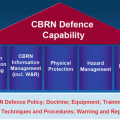© Springer Science+Business Media Dordrecht 2015
Samuel Apikyan and David Diamond (eds.)Nuclear Threats and Security ChallengesNATO Science for Peace and Security Series B: Physics and Biophysics10.1007/978-94-017-9894-5_2323. The Emerging Threat Environment and the Impact on Nuclear Preparedness
(1)
Pacific Northwest National Laboratory, Richland, WA, USA
Abstract
The emerging threat environment is dominated by several critical factors that will have significant consequences on the global security environment along with commensurate impacts on nuclear preparedness. The combination of dissolution of nation states into culturally and ethnically aligned entities, the reduction of military presence in the Middle East resulting from the withdrawal of troops from Iraq and Afghanistan, the likelihood of Iran becoming a nuclear weapon state and the recent Russian aggression in Crimea and Ukraine give rise to a geopolitical and associated threat environment that is unprecedented in recent history. This paper explores these factors and identifies some the potential security impacts as well as the likely consequences or challenges to nuclear security and preparedness. Lastly, proposed next steps for the U.S. and NATO/Europe are provided as a means to initiate a dialogue to protect against and mitigate the effects generated by these global factors.
23.1 Introduction
Preparing for a low probability, high consequence event is a complex proposition especially for events involving nuclear weapons. Yet, Americans and people around the world impacted by the attacks of September 11, 2001 and those charged with responsibility to react to the post-9/11 threat environment will recall the sense of urgency and unity of effort that went into preventing future attacks. Today, preparing is even more complicated due to the fading memory of the trauma and vulnerability felt on 9/11 and is being replaced by a sense of complacency that is not only influenced by the time since the 9/11 attacks but also by the lack of any subsequent attacks. Moreover, a growing number of the world’s population was either very young or not yet born in 2001 and the attacks have become less relevant. Also, the phenomena of a war weary country resulting from wars in Iraq and Afghanistan naturally leads to a reaction that rejects the idea that the world is a dangerous place and we must be vigilant against future aggression. It has become very difficult to generate the passion and constancy of effort we felt after 9/11.
However, we cannot ignore the evidence in front of us that not only is the world a dangerous place but all of the signs point to a geopolitical environment that is becoming both more complex and more dangerous resulting in the world facing unparalleled challenges than any in our history. While our history shows that we have been up to the task of responding to threats, it also suggests that our reaction is almost always in response to an attack rather than aggressively anticipating and preventing the attack. Because of the catastrophic and unaffordable consequences of a nuclear attack, we cannot wait to respond but, instead we must heed the evidence and work diligently to prevent the attack.
There are four principal factors that point to an emerging threat environment unlike any we have faced before. This paper intends to highlight those four factors, their implication on national and global security and identify some steps that we need to take to be prepared. The four factors are:
1.
The dissolution of nation-state control and the changing conditions in the Middle East and North Africa (MENA),
2.
The consequences of troop withdrawal from Afghanistan and Iraq,
3.
The impact of Iran’s nuclear program and its future status as a nuclear weapons state and,
4.
The implications of Russian aggression in Crimea and the Ukraine on global security.
In each case, these factors will challenge U.S. and other nations’ application of their elements of national power (e.g. diplomacy, military options, intelligence collection), but this paper will not address those in depth.
23.2 The Dissolution of Nation-State Control and the Changing Conditions in the Middle East and North Africa (MENA)
The MENA region is transitioning to an environment where affiliations to ethnical and cultural values are more important that loyalty to a national government and its control. The unrest in Egypt, Syria, Libya, and Iraq is likely to be the beginning of a larger migration of affinities to cultural interests and should be expected to be followed by similar unrest in places like Jordan, Lebanon, Bahrain and elsewhere and will last for years if not decades. This sectarian violence represents a struggle for power that could have dramatic results including the potential for redrawing national borders based on historical and cultural lines. The dramatic success of ISIS in taking control of large amounts of territory consistent with historic lines, its ability to capture large amounts of military arms and financial assets and its stated desire to do grave harm against Western interests is a clear and present danger and cannot be ignored. Meanwhile, Al Qaeda is resurging and expectations are that they will be in a power struggle with ISIS to “out gun” them in executing terrorist attacks. Meanwhile terrorist groups and freedom fighters are flowing into these struggles to seek additional influence and power. The export of those freedom fighters to the U.S., Europe and other parts of the world represents and immediate and serious threat to global security. Moreover, the exposed Southern flank of Europe could result in increased ISIS and Al Qaeda attacks.
Stay updated, free articles. Join our Telegram channel

Full access? Get Clinical Tree






